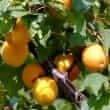Background
- Apricot generally refers to the fruit of the Prunus armeniaca tree. The tree is moderately sized with reddish bark. The fleshy fruit encloses a hard nut surrounding a droplet-shaped, reddish-brown seed or pit. Cultivation of apricot in China dates back 3,000 years and spread to Armenia, and then to Europe. The Romans introduced apricots to Europe around 70-60 B.C. through Greece and Italy.
- The most commonly used part of the apricot in alternative medicine may be the pit, which is also known as the kernel or seed. Apricot pit contains amygdalin, a plant compound that contains sugar and produces cyanide. Laetrileâ„¢, an alternative cancer drug marketed in Mexico and other countries outside of the United States, is derived from amygdalin. Laetrileâ„¢ remains unapproved by the U.S. Food and Drug Administration (FDA) and does not appear to be effective for treating cancer. Apricot pits and/or Laetrileâ„¢ may cause cyanide poisoning.
- Apricot kernels and oils have been historically used to treat tumors. The Japanese folk remedy bainiku-ekisu (concentrated Japanese apricot juice) has been used for the treatment of gastritis (stomach inflammation) and enteritis (bowel inflammation) since ancient times, and has recently been studied as a bacteriostatic (stops the growth/reproduction of bacteria) agent. Amygdalin may also be useful for AIDS patients, psoriasis, and hyperoxia (excess of oxygen).
References
Natural Standard developed the above evidence-based information based on a thorough systematic review of the available scientific articles. For comprehensive information about alternative and complementary therapies on the professional level, go to . Selected references are listed below.
- Araya E, Rodriguez A, Rubio J, et al. Synthesis and evaluation of diverse analogs of amygdalin as potential peptidomimetics of peptide T. Bioorg.Med Chem Lett. 3-1-2005;15(5):1493-1496.
View Abstract - Bhatti RA, Ablin RJ, Guinan PD. Tumour-associated directed immunity in prostatic cancer: effect of amygdalin. IRCS Med Sci 1981;9(1):19.
- Hill GJ, Shine TE, Hill HZ, et al. Failure of amygdalin to arrest B16 melanoma and BW5147 AKR leukemia. Cancer Res 1976;36(6):2102-2107.
View Abstract - Laster WR Jr, Schabel FM Jr. Experimental studies of the antitumor activity of amygdalin MF (NSC- 15780) alone and in combination with beta-glucosidase (NSC-128056). Cancer Chemother Rep 1975;59(5):951-965.
View Abstract - Lea MA, Koch MR. Effects of cyanate, thiocyanate, and amygdalin on metabolite uptake in normal and neoplastic tissues of the rat. J Natl.Cancer Inst. 1979;63(5):1279-1283.
View Abstract - Moertel CG, Fleming TR, Rubin J, et al. A clinical trial of amygdalin (Laetrile) in the treatment of human cancer. N.Engl.J.Med. 1-28-1982;306(4):201-206.
View Abstract - Morrone JA. Chemotherapy of inoperable cancer: preliminary report of 10 cases treated with laetrile. J Exper Med Surg 1962;20:299-308.
- Moss RW. Patient perspectives: Tijuana cancer clinics in the post-NAFTA era. Integr.Cancer Ther 2005;4(1):65-86.
View Abstract - Navarro MD. The Philippine experience in the early detection and chemotherapy of cancer. Santo Tomas J Med 1970;25(3):125-133.
- Ovejera AA, Houchens DP, Barker AD, et al. Inactivity of DL-amygdalin against human breast and colon tumor xenografts in athymic (nude) mice. Cancer Treat.Rep 1978;62(4):576-578.
View Abstract - Ross WE. Unconventional cancer therapy. Compr.Ther 1985;11(9):37-43.
- Smith FP, Butler TP, Cohan S, et al. Laetrile toxicity: a report of two patients. Cancer Treat.Rep 1978;62(1):169-171.
View Abstract - Syrigos KN, Rowlinson-Busza G, Epenetos AA. In vitro cytotoxicity following specific activation of amygdalin by beta-glucosidase conjugated to a bladder cancer-associated monoclonal antibody. Int J Cancer 12-9-1998;78(6):712-719.
View Abstract - Vickers A. Alternative cancer cures: "unproven" or "disproven"? CA Cancer J Clin 2004;54(2):110-118.
View Abstract - Wodinsky I, Swiniarski JK. Antitumor activity of amygdalin MF (NSC-15780) as a single agent and with beta-glucosidase (NSC-128056) on a spectrum of transplantable rodent tumors. Cancer Chemother Rep 1975;59(5):939-950.
View Abstract







